-
PDF
- Split View
-
Views
-
Cite
Cite
C. S. Graham, L. R. Baden, E. Yu, J. M. Mrus, J. Carnie, T. Heeren, M. J. Koziel, Influence of Human Immunodeficiency Virus Infection on the Course of Hepatitis C Virus Infection: A Meta-Analysis, Clinical Infectious Diseases, Volume 33, Issue 4, 15 August 2001, Pages 562–569, https://doi.org/10.1086/321909
Close - Share Icon Share
Abstract
Studies have shown that rates of liver disease are higher in persons who are coinfected with human immunodeficiency virus (HIV) and hepatitis C virus (HCV) than they are in persons with HCV alone, but estimates of risk vary widely and are based on data for dissimilar patient populations. We performed a meta-analysis to quantify the effect of HIV coinfection on progressive liver disease in persons with HCV. Eight studies were identified that included outcomes of histological cirrhosis or decompensated liver disease. These studies yielded a combined adjusted relative risk (RR) of 2.92 (95% confidence interval [CI], 1.70–5.01). Of note, studies that examined decompensated liver disease had a combined RR of 6.14 (95% CI, 2.86–13.20), whereas studies that examined histological cirrhosis had a pooled RR of 2.07 (95% CI, 1.40–3.07). There is a significantly elevated RR of severe liver disease in persons who are coinfected with HIV and HCV. This has important implications for timely diagnosis and consideration of treatment in coinfected persons.
Hepatitis C virus (HCV) is a significant public health concern; it affects 3.9 million persons in the United States and an estimated 170 million persons worldwide [1, 2]. Those persons with repeated exposure to blood or blood products are at risk for both HIV and HCV infection. An estimated 60%–90% of persons with hemophilia and 50%–90% of injection drug users who have HIV are coinfected with hepatitis C [3]. Currently, injection drug users account for 60% of the persons with newly acquired cases of HCV infection in the United States, as well as 22% of AIDS cases in men and 42% of AIDS cases in women [3, 4]. Therefore, coinfection with HIV and HCV will be an increasing problem in the coming years.
Studies on the natural history of HCV infection in immunocompetent persons have demonstrated that cirrhosis typically develops 20–30 years after the first exposure to the virus [5-7]. Numerous factors have been associated with an increased risk of progression to cirrhosis, including male sex, older age at the time of acquisition of HCV, and excessive alcohol consumption [8]. Conversely, persons who are young when they are exposed to HCV appear to have a more benign course of infection [7, 9]. Approximately 6% of immunocompetent hosts can be expected to develop hepatic decompensation due to cirrhosis during a 20-year period [8].
Reports from early in the AIDS epidemic noted unusually rapid progression to cirrhosis in persons with HIV [10]. Several studies of cohorts of patients with hemophilia have found that the rates of liver failure are higher in HIV-HCV-coinfected persons than they are in persons who were infected with HCV alone [11-15]. More recently, studies that have included more injection drug users have shown a similar acceleration of liver disease in the setting of HIV and hepatitis C coinfection, but estimates of the risk of progression vary widely [16-18].
With the introduction of combination antiretroviral therapy (highly active antiretroviral therapy, or HAART) in the mid-1990s, a sharp decrease in the number of AIDS-related deaths was seen in the United States [3]. Because infected persons who are receiving HAART live longer, the complications of HCV-induced liver disease are becoming more prominent. A recent study found that HCV was the leading non-AIDS cause of death in coinfected persons, and another study found that 50% of deaths in a cohort of patients with HIV in 1998 were the result of end-stage liver disease [19, 20]. At the same time, decisions about whether to initiate antiviral therapy for HCV have to balance the benefits of therapy with its risks [21]. Given the toxicities of the currently available anti-HCV regimens, understanding the overall risk faced by a coinfected person is paramount in decisions related to evaluation and therapy for hepatitis C.
We performed a meta-analysis of studies that examined the differential impact of HIV on HCV in terms of the clinically unambiguous end points of decompensated liver disease and biopsy-proven cirrhosis. The aims of this analysis include summarizing the main characteristics of the included studies, providing a point estimate of the effect of HIV-HCV coinfection on progressive liver disease (compared with HCV monoinfection), examining potential heterogeneity between studies, and identifying potential confounding variables in these studies.
Methods
Literature search. Computerized, English-language literature searches were performed via the MEDLINE database (January 1966-June 1999) for published human studies that examined how the course of hepatitis C infection is altered by concurrent HIV infection. For the search, the terms “HIV,” “AIDS,” “human immunodeficiency virus,” or “acquired immunodeficiency syndrome,” and either “hepatitis C” or “HCV,” had to have been present in key words, titles, or abstracts. The bibliographies of selected articles and review articles were also searched for pertinent studies.
Criteria for inclusion and exclusion. Only full-length, peer-reviewed, original journal articles were considered for inclusion. Articles that did not obviously include populations of patients who were infected with HCV and HIV and that did not obviously examine clinical outcomes of liver disease were excluded. The remaining articles were independently examined in detail by at least 2 of the observers for the following criteria: (1) populations with HIV-HCV coinfection were compared with populations with HCV monoinfection; (2) HCV infection was defined by a positive result of a second- or third-generation HCV ELISA and was confirmed by means of recombinant immunoblot assay or PCR; (3) HIV infection was defined by a positive result of an HIV ELISA and was confirmed by means of a Western blot assay; (4) populations selected for study did not exclude living patients to avoid bias against nonterminal severe liver disease; and (5) outcomes included a histopathological diagnosis of cirrhosis that used the criteria defined by Knodell et al. [22] or clinically defined decompensated liver disease that was defined unambiguously as the presence of ⩾2 of the following conditions: bleeding esophageal varices, ascites, hepatic encephalopathy, or persistent conjugated hyperbilirubinemia not attributable to medications.
To be able to compare results across studies, the frequently reported histological criteria of cirrhosis, as defined by Knodell et al. [22], were used. When ⩾1 report appeared to describe the same cohort of patients (which we established on the basis of the cohort location and authors involved), we selected the most recent or the most complete study.
Statistical analyses. Quantitative data on the number of cohort subjects with HCV monoinfection or HCV-HIV coinfection was extracted, as was the number of patients in each infection group with the outcome of clinical decompensated liver disease or histological cirrhosis. Contingency tables were created, and results were converted to relative risks (RRs). Eyster et al. [12] reported no clinical events in the control group; therefore, 1 clinical event was added to this cell of data to allow the calculation of the RR. We extracted 95% CIs from the studies or calculated them. When adjusted RRs or risk ratios were included, these were extracted directly. Benhamou et al. [23] used a matched cohort study design to adjust for matched variables, and the extracted RR is presented as an adjusted value. For studies that reported risk ratios, we assumed that the incidence of the outcome of interest was low enough to combine these values with RRs.
For one study [18], sufficient data were present to calculate an adjusted RR on the basis of duration of HCV infection by means of logistic regression. The variance of the natural log of the RR was calculated for each study. We used both the fixed-effect models and random effect models described by DerSimonian and Laird [24] to obtain summary estimates from the included studies. The STATA software package (STATA) was used for all analyses [25].
Results
Search results. The MEDLINE search yielded 1290 possible articles; 1246 articles were eliminated by review of titles and abstracts. The remaining 44 articles were reviewed in detail, and 36 of these articles were excluded. (Excluded articles and reasons for exclusion are available upon request.) The 8 articles that were included in our analysis are shown in table 1.
Summary of studies included in the meta-analysis relating to the impact of HIV on hepatitis C virus (HCV)-induced liver disease.
Qualitative review. The studies' subject population ranged in size from 55 to 547 patients. In total, we evaluated data regarding 1871 HCV-positive patients, 601 of whom were positive for HIV and 1370 of whom were negative for HIV (table 1). Two studies assessed decompensated liver disease alone [12, 26], 4 studies assessed histological cirrhosis alone [16, 18, 23, 27], and 2 studies assessed both outcomes [13, 15]. The sex distribution of all 8 cohorts was overwhelmingly male: 92%–100% of the subjects were male in the 4 retrospective cohorts in which a large majority of patients had hemophilia [12, 13, 15, 26] and 65%–75% of the subjects were male in the 4 other studies [16, 18, 23, 27]. All studies had similarly aged cohorts (table 1).
In studies of immunocompetent persons, important cofactors for HCV-related liver disease include alcohol consumption and the presence of hepatitis B virus (HBV) [8]. Five studies in our analysis attempted to assess the significance of alcohol use by means of exclusion of patients who consumed alcohol excessively [18], qualitative description [13, 15], or quantification of grams of alcohol consumed per day [16, 23]. Because of the various methods of describing alcohol consumption in these studies, this important factor could not be incorporated into further analyses. Three studies excluded patients with detectable hepatitis B surface antigen from their cohorts [16, 18, 23], and Eyster et al. [12] analyzed their cohort with and without patients who tested positive for HBV surface antigen. The other 4 studies [13, 15, 26, 27] reported the number of patients with positive HBV surface antigen (table 1).
Duration of HCV infection has been shown to correlate with progression of HCV-related liver disease in immunocompetent persons [8] In all studies except that of Bierhoff et al. [27], duration of hepatitis C infection was assessed. In these studies, HCV infection was typically assumed to be the date of first exposure to clotting factor concentrate, blood transfusion, or initiation of injection drug use. Benhamou et al. [23] calculated a “fibrosis progression rate” that estimated the change in fibrosis stage during the course of time. The degree of immunodeficiency is likely another important variable in the progression of liver disease. Six of the studies assessed the CD4 cell count but all reported the values differently [12, 15, 16, 18, 23, 26]. Four studies determined the duration of HIV infection [12, 13, 15, 26]. The majority of cohort data was collected before the widespread use of HAART. Only Benhamou et al. [23] attempted to analyze the role of HAART in the progression of HCV liver fibrosis, and only 10.9% of the patients in that cohort were receiving HAART.
Univariate results. In 4 studies [12, 13, 15, 26] the RR for decompensated liver disease ranged from 2.83 to 14.73 (table 2). In 2 studies [15, 26], RRs were considered statistically significant at the P < .05 level. The RRs for histological cirrhosis ranged from 0.76 to 1.74, and none of the individual results reached statistical significance [13, 16, 18, 27].
Relative risk estimates from the 8 studies used in the meta-analysis.
Adjusted results. Adjusted RRs or risk ratios were obtained directly from each study, with the exception of the study by Soto et al. [18], in which it was calculated from the data provided. The adjusted RR for decompensated liver disease [12, 13, 15, 26] ranged from 3.2 to 21.4; in 2 of the studies [15, 26], it achieved statistical significance (table 2). Four studies [13, 16, 18, 23] assessed the adjusted RR for cirrhosis with point estimates that ranged from 1.46 to 3.90; in only 2 of the studies were the RRs statistically significant [13, 16].
Effect of duration of HCV infection. The effect of duration of HCV infection on progression to severe liver disease was addressed by all studies except that of Bierhoff et al. [27], although we were unable to determine the differential effect of the duration of HCV infection in HIV-HCV-coinfected patients in 2 other studies [13, 26]. Four studies found an accelerated progression to severe liver disease in HIV-HCV-coinfected patients compared with HCV-monoinfected patients [12, 15, 18, 23]. Soto et al. [18] stratified patients with cirrhosis by duration of HCV infection in years. By use of logistic regression to combine strata, the 15-year RR for histological cirrhosis was 1.94 (95% CI, 0.92–4.07) for HIV-HCV-coinfected patients, compared with patients with HCV monoinfection. When we stratified patients with cirrhosis solely by duration of HCV infection in the study by Pol et al. [16], we found an adjusted OR of 2.42 (95% CI, 1.15–5.09). Eyster et al. [12] found that HIV-HCV-coinfected patients had a cumulative incidence of liver decompensation (±SD) of 27% ± 10% at 40 years after first blood transfusion and 42% ± 14% at 27 years after exposure to clotting factor concentrates; no HCV-monoinfected patient developed liver decompensation. In Telfer et al. [15], 5 of the 10 cohort patients with HIV-HCV coinfection who developed decompensated liver disease did so within 15 years of exposure to HCV, compared with none of the HCV monoinfected patients. Benhamou et al. [23] described mean rates of fibrosis progression for HIV-HCV-coinfected patients of 0.181 (95% CI, 0.162–0.20) fibrosis units per year, which translated into a mean duration from HCV infection to cirrhosis of 26 years (95% CI, 22–34). HCV-monoinfected patients had a mean rate of fibrosis progression of 0.135 fibrosis units per year (95% CI, 0.126–0.144), or a mean duration of 38 years from HCV infection to cirrhosis (95% CI, 32–47).
Meta-analysis. The combined unadjusted RR for the 8 studies was 2.14 (95% CI, 1.15–3.97) by the random effect model. The test for heterogeneity was significant at P = .024, so the random effect model was used for subsequent analyses. Because Makris et al. [13] examined cases of both decompensated liver disease and histological cirrhosis, the RR of decompensated liver disease was selected to represent the study findings because it included the entire cohort, as opposed to the subpopulation of patients who were selected for liver biopsy. By use of adjusted data, the combined RR was 2.92 (95% CI, 1.70–5.01; figure 1).
Analysis of studies, denoted by first author name, that examined the adjusted RR of decompensated liver disease or histological cirrhosis in patients with HIV-hepatitis C virus (HCV) coinfection, compared with patients who have HCV infection alone. The RR for each study (squares) and 95% CI (bars) are displayed on a logarithmic scale, as well as the combined RR with 95% CI (diamond). The size of the squares is inversely proportional to the variance of the studies.
We also performed subgroup analyses determined a priori. A comparison of studies that evaluated decompensated liver disease with those that evaluated histological cirrhosis revealed substantial differences in RRs. Studies that examined the end point of histological cirrhosis alone had a combined unadjusted RR of 1.08 (95% CI, 0.74–1.58) [13, 16, 18, 27], whereas studies that examined the end point of decompensated liver disease had an unadjusted RR of 4.78 (95% CI, 2.26–10.09) [12, 13, 15, 26]. The combined adjusted RR for histological cirrhosis was 2.07 (95% CI, 1.40–3.07) [13, 16, 18, 23], whereas that of decompensated liver disease was 6.14 (95% CI, 2.86–13.20; figure 2) [12, 13, 15, 26]. We attempted to compare studies that involved cohorts of patients who had hemophilia with studies that involved mixed cohorts that included injection drug users. However, the studies that involved patients with hemophilia [12, 13, 15, 26] used the outcome of decompensated liver disease, whereas the study cohorts that included both injection drug users and patients with exposure to blood products [16, 18, 23, 27] examined the outcome of histological cirrhosis. Only the study by Makris et al. [13] would have provided us with additional information, so this analysis is not shown.
Analysis of studies, denoted by first author name, that examined the adjusted RR of (A) histological cirrhosis or (B) decompensated liver disease in patients who have HIV-hepatitis C virus (HCV) coinfection, compared with patients who have HCV infection alone. The RR for each study (squares) and 95% CI (bars) are displayed on a logarithmic scale, as well as the combined RR with 95% CI (diamonds). The size of the squares is inversely proportional to the variance of the studies. Note the differences in scale.
Discussion
Reports on causes of death in persons with hemophilia in the 1970s indicated that deaths due to chronic liver disease represented 6%–8% of deaths, most of which were probably due to HCV [28, 29]. In the 1980s, the clinical impact of HCV was overshadowed by a substantial increase in deaths due to HIV [30]. With the advent of HAART, patients with HIV are now living longer lives and facing the complications of other infections such as HCV. This meta-analysis estimates the overall RR of decompensated liver disease or histological cirrhosis to be 2.92 (95% CI, 1.70–5.01) by use of adjusted data. This value is comparable to the OR of 2.9 (95% CI, 1.3–6.2) for persons with chronic liver disease due to concomitant HCV and excessive alcohol intake, compared with those persons who have HCV alone [31].
However, understanding the populations that we studied is important in determining generalizability to other populations. Half of the cohorts were composed of persons with hemophilia; therefore, ∼85% of the patients studied were of male sex. All of the studies were from Europe or North America. Three studies performed HCV genotyping on a portion of their cohorts and found 48%–58% of the genotypes to be 1a or 1b [16, 18, 23]. Only Eyster et al. [12] described the racial background of the patients included in the study, and their cohort was 97% white. Caution should be taken in generalizing the results of this meta-analysis to women and racial or ethnic populations that may not have been represented in these studies; all of these factors potentially impact the natural history of HCV infection.
Although each study adjusted its data for a different set of covariates, the lower combined RR found by use of unadjusted data (2.14 [95% CI, 1.15–3.97]) suggests that studies that do not account for confounders may have inappropriately low estimates of the effect of HIV on HCV-related liver disease. In fact, only 2 of the 8 studies [15, 26] found significantly elevated RRs in their unadjusted data. Although it was difficult to compare HIV-HCV-coinfected patients with HCV-monoinfected patients with regard to the effect of duration of HCV infection on progression to severe liver disease, 3 studies found that a higher proportion of HIV-positive patients developed severe liver disease with <15 years' exposure to HCV [15, 16, 18]. Benhamou et al. [23] estimated that the time from exposure to HCV to cirrhosis was 26 years for HIV-HCV-coinfected patients, compared with 38 years for HCV-monoinfected patients. The estimation of duration of HCV infection is imperfect, but it appears to be an important effect modifier on the impact of HIV in HCV-related liver disease.
Duration of HIV infection, degree of immunosuppression, and the timing of HIV exposure relative to HCV exposure may also be important. Makris et al. [13], for example, classified 2 patients as HIV-HCV-coinfected patients who had evidence of cirrhosis before documented infection with HIV, whereas Eyster et al. [12] found a cumulative incidence of liver failure (±SD) of 17% ± 4% 10 years after acquisition of HIV infection. Five studies in this meta-analysis found an increased risk of severe liver disease in those patients who had lower CD4 counts or who had AIDS [12, 15, 23, 26, 32].
We found striking differences between studies that examined the end point of decompensated liver disease and those that examined histological cirrhosis. The combined adjusted RR for decompensated liver disease was 6.14 (95% CI, 2.86–13.20), whereas for histological cirrhosis, it was 2.07 (95% CI, 1.40–3.07). Possible explanations for the discrepancy between these 2 end points of severe liver disease include the following: (1) there were methodological differences in study design; (2) there was bias in the selection of patients to have biopsies performed; for instance, HIV-HCV-coinfected patients who had a biopsy of the liver performed had less advanced liver disease than did the total population of coinfected patients; (3) the relative impact of HIV-HCV coinfection in populations with hemophilia is more severe because studies that found the highest RRs examined populations with hemophilia; or (4) there is a smaller difference between HIV-HCV-coinfected patients and HCV-monoinfected patients with regard to the development of cirrhosis, but there is a substantial increased risk of developing decompensated liver disease once cirrhosis is present.
The available data do not allow us to distinguish between these possibilities. However, we suspect that selection bias was a factor, given that Soto et al. [18], Pol et al. [16], and Bierhoff et al. [27] included patients in their studies who had been referred for liver biopsy, whereas the studies that examined the end point of decompensated liver disease included all patients who received care at their respective institutions. Given the current data, we believe the combined adjusted RR for the end point of decompensated liver disease represents the least biased estimate of the differential effect of HIV on severe liver disease that was related to HCV.
Additional variables that were found to be important confounders or effect modifiers in the studies included age at the time of acquisition of HCV and levels of alcohol consumption. Chronic HBV infection could be an important confounder; however, 3 studies [16, 18, 23] excluded patients who ad evidence of hepatitis B surface antigen from their cohorts, and we excluded patients with HBV surface antigen in our analysis of the Eyster et al. [12] cohort. In the other studies, there were only 11 patients with detectable HBV surface antigen, which was unlikely to have affected our results.
There are other factors that may have influenced the level of liver damage in HIV-HCV-coinfected patients that we were unable to address in our analysis. Benhamou et al. [23] found a trend of less fibrosis progression in those patients who were also treated with HAART for HIV, a finding that recently has been confirmed [33]. However, the other studies were performed before the widespread use of HAART, and its impact on the progression of HCV-induced liver disease needs to be explored. Other studies have found an increase in the levels of transaminase or frank liver decompensation in patients treated with HAART [34-36]. Possible etiologies include drug toxicity or “immune reconstitution” [37], because cellular immunity is thought to mediate the liver damage seen in patients with HCV infection [38].
In summary, analysis of these data shows that the risk of severe liver disease is significantly increased in patients who are coinfected with HIV and HCV, compared with those patients who have HCV monoinfection. This risk is modified by the duration of HCV infection, because the progression to decompensated liver disease or cirrhosis occurs earlier in HIV-coinfected patients. Important areas for further study include the effects of HAART on HCV-related liver disease progression and the addition of detailed histories of substance use, including alcohol consumption. The large discrepancy between studies that examined end points of histological cirrhosis or decompensated liver disease needs to be explored further. Comparison of future studies would also benefit from inclusion of detailed information regarding duration of HCV infection and uniform reporting of histological data.
As the life expectancy of patients with HIV improves, the clinical impact of HCV as a comorbid condition may be increasingly noticed. Patients with HIV need to be evaluated for HCV infection, and we agree that HCV should be defined as an opportunistic infection in patients with HIV [26]. Future studies should focus on ways to impact the natural history of HCV infection, including the impact of antiviral therapy directed against HCV.
Acknowledgements
We are grateful for the expert guidance and advice of Richard Stoto, Ph.D., who taught a research synthesis course at the Harvard School of Public Health from which this work originated.



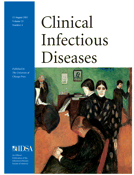
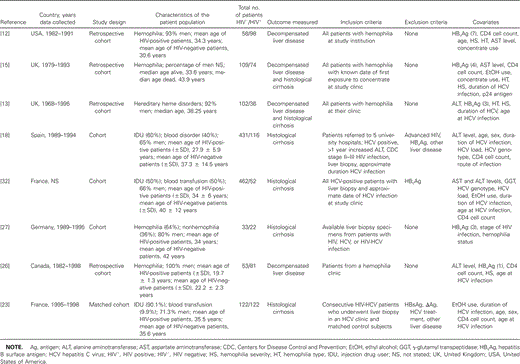
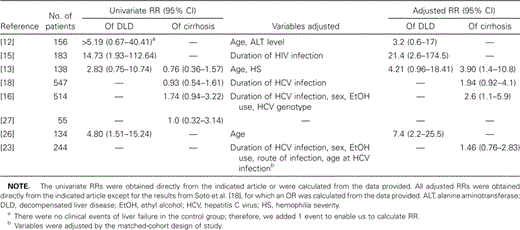
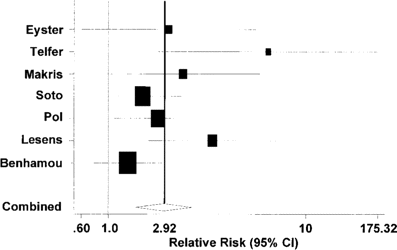
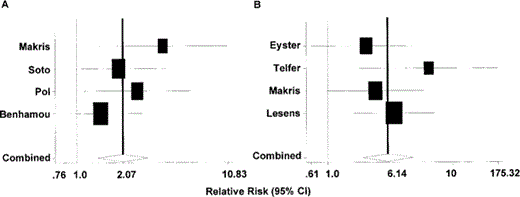

Comments